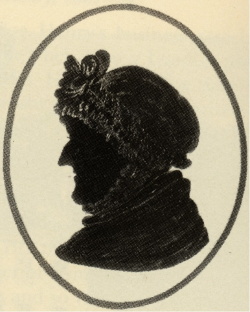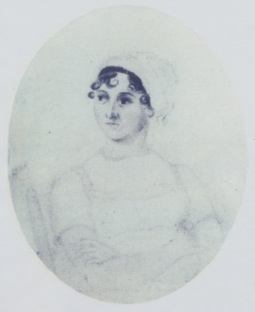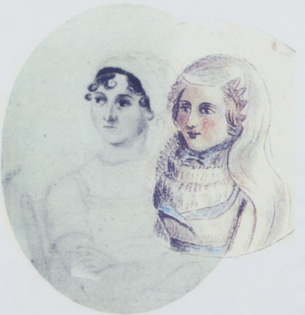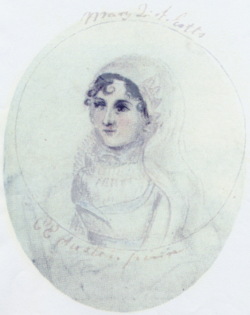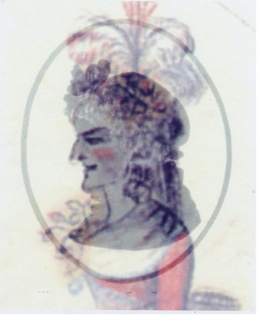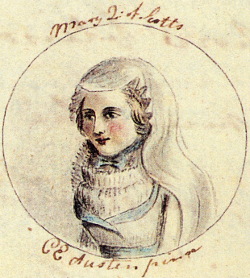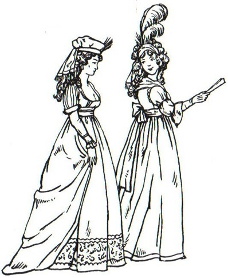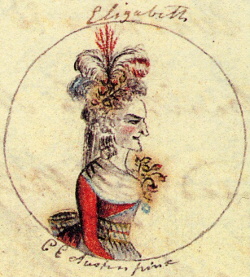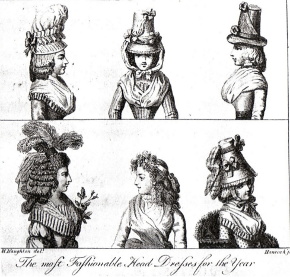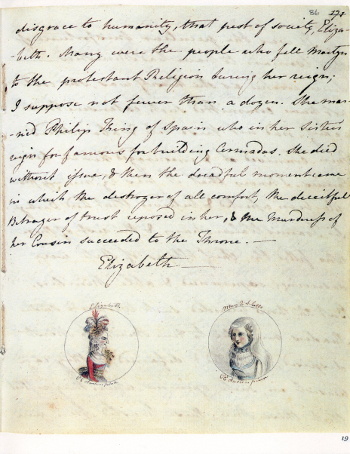|
Two hundred years ago, in July 1809, Jane Austen arrived in Chawton, the small Hampshire village that would be her home for the final eight years of her life. Somewhere packed away in Austen’s belongings were three treasured little manuscript notebooks of her juvenilia, titled rather grandly Volume the First, Volume the Second, and Volume the Third, transcripts of stories she had written as a young teenager at Steventon Rectory. One item, “The History of England” in Volume the Second, had a special significance as a collaboration between the two Austen sisters, with Cassandra supplying miniature portraits of the monarchs to accompany Austen’s text in a direct parody of Oliver Goldsmith’s 1771 The History of England. Our recent research, published in 2009 in the Juvenilia Press edition of Jane Austen’s The History of England & Cassandra’s Portraits, and launched at Chawton House Library, suggests that Cassandra then enhanced the joke by using portraits of family members and friends as individual monarchs, including her sister Jane, whose image appears as a youthful Mary, Queen of Scots, together with an opposing and unflattering portrait of their mother, depicted as the evil Queen Elizabeth of Austen’s hostile text. The equation between Cassandra’s portraits and Austen family likenesses has not previously been recognized, but once the correlation is made, the discovery presents Austen readers with the opportunity to explore new biographical directions in Austen scholarship.
Discoveries and revelations, however, can be disturbing and challenging, and the new interpretation offered in our edition and this essay of an unhappy relationship between Jane Austen and her mother—based on their opposing portraits and their identification in relation to Austen’s text—is immediately in conflict with traditional readings of her cheerful childhood home, and loving, supportive parents. But the records of Austen’s childhood at Steventon Rectory are scanty, and the account handed down to us is a much later impression by the next generation of Austens; it is inevitably colored by a sense of fond remembrance of their now famous late relative and by pride in the status she adds to the family name. However appealing and long-standing, this view is open to challenge.
Jane Austen as biographical subject is relevant to literary studies and critical interpretations of her works. It is a truism that biographers are their own subjects; conceivably the same could be true of many historians, especially when the playful author announces on her title page that she intends to be “a partial, prejudiced, and ignorant Historian” (Juvenilia 176). Our argument is that The History of England is in some sense a representation of the Austen family. On the face of it, it is not unlikely that a lively fifteen-year-old might choose to parody her own family and friends as historical figures, or to persuade her artist sister to join in the joke.1 This new interpretation of Austen’s History makes a biographical claim that Cassandra’s images of the monarchs represent Austen family members and friends. More important, it presents evidence that Cassandra’s images of her mother as Elizabeth and her sister Jane as Mary, Queen of Scots, when interpreted within the context of the chapter on Elizabeth, provide a key to access the text’s other identity as an autobiographical record.
Claudia Johnson writes of a wide reading public “passionate and opinionated about virtually everything that pertains to [Austen]” (“Fair Maid” 14). The traditional reading of Austen’s happy childhood that originated in James Edward Austen-Leigh’s Memoir of Jane Austen is widely accepted, even cherished, in Austen biography. This traditional interpretation is given a factual or categorical authority that not only resists challenge but is also generally represented in emotive terms that imply some kind of betrayal of Austen and her family by the luckless critic. The revelation of Cassandra’s portraits of Jane Austen and her mother, and their implications for the interpretation of Austen’s text, may yet prove too unsettling, too revealing to be admitted into Austen biography. This essay suggests, however, that it is rewarding to challenge restrictive readings of Austen biography.
Volume the Second and family secrets
The younger generation of Austen nieces and nephews, who later recorded their memories of their famous aunt, were not aware of the notebook entitled Volume the Second. On Cassandra’s death in 1845 at the age of seventy-three, it descended to her brother, Vice-Admiral Sir Francis Austen. Jane Austen’s History includes a fond allusion to this young sailor brother, then on service as midshipman, and compares his future naval career to that of the famous Sir Francis Drake, but despite this flattering reference, the elderly Sir Francis kept the notebook hidden from his own family.2 His second wife, Lady Austen (née Martha Lloyd), intimate friend of the Austen sisters, had died two years earlier, but his youngest daughter Fanny Sophia Austen still lived at home. Another daughter, Catherine Hubback, returned to the family home with her three young sons in 1850 and lived there for eight years after her barrister husband was committed to an asylum. Catherine, in her teenage years, had been a favorite with Aunt Cassandra, who made long visits to Francis and his family, and she had even been permitted to read some of Austen’s letters that Cassandra would later destroy. Catherine Hubback was also devoted to Austen’s memory and in 1850 published her own novel, The Younger Sister, partly based on the unfinished fragment now known as “The Watsons,” which she had read with Aunt Cassandra.
In 1906 Catherine’s eldest son, John Henry Hubback, and granddaughter Edith Charlotte Hubback published an account of the naval career of Francis and Charles Austen, Jane Austen’s Sailor Brothers. In the Preface, John Henry Hubback recalls a childhood “spent chiefly in the house of my grandfather, Sir Francis,” and adds: “Surrounded by reminiscences of the opening years of the century, the Admiral always cherished the most affectionate remembrance of the sister who had so soon passed away, leaving those six precious volumes to be a store of house-hold words among the family” (vii-viii). This family, however, who cherished every connection to Jane Austen, had no idea that another “precious volume” of her writing was locked away somewhere in the house. In Jane Austen’s Sailor Brothers, every known detail of Francis Austen’s relationship to his famous sister is proudly recounted, including extracts from Austen’s letters, but there is no reference to the manuscript notebook or to The History of England with its compliment to Francis Austen that would have delighted his children and grandchildren. It seems likely that John Henry Hubback in 1906 was still unaware of the bequest of the notebook to his late grandfather.
Sir Francis Austen may have had good reason for withholding this volume from his family. Since Mrs. Austen had died only in 1827, several of the adult children of Francis had memories of their grandmother and might have recognized her image in the manuscript as the “wicked” Elizabeth. The implication that the teenage Jane and Cassandra had ridiculed their mother at the time of composition, would have been a piece of family history not to be communicated to the next generation.
Cassandra’s images and their identity
Jane Austen ended The History of England with the note “Finis Saturday Nov. 26th 1791” (189) and transcribed this work into Volume the Second, in a period that can be dated from May to November 1792. Cassandra was also working on the images during this period, and they were probably completed by early 1793.3 There are thirteen portraits of monarchs, of which seven (possibly eight)—through a comparison of existing miniatures and other family representations, and supported by biographical evidence—can be tentatively identified as Austen family members and friends. The images for comparison were examined by experts in the separate fields of odontology and geomatics, Pamela Craig and Clifford Ogleby.4
Cassandra’s artistic talent and ability to take a reasonably accurate likeness was a skill, in these days before photography, highly valued and encouraged in women, if only in the private sphere of the family. Provided she was not working directly into her sister’s notebook, Cassandra could make sketches of available family members without arousing suspicion of an ulterior motive and then use them for her finished copy in the History. Textual references link the portraits to particular family members. The most obvious is the clue that the images correspond, wherever possible, to family members and friends of the same name. The brothers James, Edward, and Henry, for example, are depicted as James I, Edward VI, and Henry V respectively.
Jane Austen is represented as the youthful, slightly built, and very attractive Mary, Queen of Scots, with a lively face and dressed in her finery ready to impress at a ball, an image perhaps not inconsistent with the comment that “she was then the prettiest, silliest, most affected, husband-hunting butterfly.”5 The gown is only partially visible but the style can be identified as the classic “open robe,” fashionable as formal dress of the early 1790s. The headband worn by Mary is particularly interesting and may be directly linked to the young Jane Austen, who received a similar gift in 1783, after the sudden death of her aunt, Mrs. Jane Cooper (Le Faye 49). Austen refers to this headband in a letter of 1 November 1800, and, as in the image of Mary, uses it to secure her muslin veil that matches the gown: “I wore at the Ball your favourite gown, a bit of muslin of the same round my head, border’d with Mrs Cooper’s band—& one little Comb.”
Cassandra’s portrait of her mother, Mrs. Austen, aged fifty-two, as Queen Elizabeth, shows an ugly, even grotesque woman, dressed formally in the style of the early 1790s. The costume worn by Elizabeth resembles fashion illustrations in the English Ladies Pocket Companion of 1792, in the style and fold of the handkerchief around the bodice area, and particularly in the feathers in the headdress and the artificial flowers at the breast. By 1794 fashion had changed again, and the short feathers shown in this image were replaced by “enormous ostrich plumes in the hair” (Brooke and Laver 86).
A room of their own
Virginia Woolf’s famous image of the fifteen-year-old Austen at work on her juvenilia “in her private corner of the common parlour” (170) is misleading. The “common parlour” was usually occupied by the Reverend George Austen’s students. The sisters had been allocated an upstairs sitting-room or “dressing room,” as they called it, adjoining their bedroom: “[t]his room belonged exclusively to the two sisters. Here they followed their favourite pursuits—Cassandra had her drawing materials, and Jane her desk and her piano” (Hill 84). Here Austen wrote her other works of the juvenilia and the first drafts of Pride and Prejudice and Sense and Sensibility.
The need to keep her work private from the family, discussed fully only with Cassandra, began in childhood. A niece, Anna Lefroy, who lived as a small child at the rectory, “could remember being noticed and played with by the pupils—and hearing Pride and Prejudice [First Impressions] read aloud by Jane to her sister” (F. C Lefroy). Anna’s chatter in the family rooms downstairs about Jane and Elizabeth began to “provoke enquiry, for the story was still a secret from the elders.”
It is likely that the transcribed notebooks of the juvenilia were also kept secret from the “elders.”6 From childhood Jane had presented examples of her finished work to individual family members before transcribing them into her notebooks, and there is a reference to these “early compositions” in the Memoir (39). Austen-Leigh’s comments however are limited by his own slight knowledge of both Austen’s childhood and the juvenilia itself. He had inherited Volume the Third, which is dated May 1792 (when Austen was sixteen), but he excludes these stories as “another stage of her progress” and makes it clear that he is referring in his comments on the juvenilia to her earlier, childhood work (39-40). He was unaware, however, of the notebook Volume the Second, while Volume the First, left to Austen’s youngest brother Charles Austen, had disappeared in the family after his death in 1852. R. W. Chapman describes Volume the First as “long lost” (162), and Southam considers that Austen-Leigh only had access to extracts copied by family members (“Manuscript” 231). These samples from Austen’s earliest works are described in the Memoir as “juvenile effusions” (40).
Austen-Leigh also refers to a message his sister Caroline, as a child of twelve, had received from Aunt Jane, advising her to cease writing until the age of sixteen, and commenting “that she herself had often wished she had read more, and written less in the corresponding years of her own life” (42). He then notes that “these words seem to imply” that some of these juvenile tales “had been written in her childhood” (42). There is evidently no family tradition to confirm that Austen wrote stories as a child, and he has no further knowledge of Austen’s early writing practices or the audience for these works but simply speculates from the dedications that they were intended as “the kind of transitory amusement which Jane was continually supplying to the family party” (40).
Eric Daffron analyzes how Austen-Leigh’s judgment of the juvenilia as “juvenile effusions” has shaped critical response, and he notes that some modern critics “still deride her early work” (194). The critical reception of the juvenilia as family entertainment is perhaps even more securely entrenched but, like other traditions originating in the Memoir that are based on surmise and scanty evidence, is open to challenge. Volume the First finally emerged in 1933 and was purchased by the Bodleian Library. Austen-Leigh’s assessment of these early items as intended for the “family party” is implicitly denied by Cassandra Austen’s message on the endpaper of this notebook, to her brother Charles, recalling that “a few of the trifles in this Vol: were written expressly for his amusement.” In November 1791, when Austen completed her History, she and Cassandra were the only siblings still living at home. The dedications of items in Volume the Second include Cassandra for the History itself, and other close relatives and trusted associates from the younger generation: her brother Henry and cousins Eliza de Feuillide and Jane Cooper. These were all staying at the rectory in late 1792 after the History was transcribed into the notebook and would have been entertained by the sisters in their private sitting-room upstairs. The dedications are consistent with a select audience for these works. As Reginald Farrer suggests, “[H]er only real intimate at home was her sister Cassandra, and it is significant that only upstairs, behind her shut door, did she read her own work aloud, for the benefit of her chosen circle in the younger generation” (247).
Jane Austen’s History is first and foremost a burlesque on the presentation of history in popular texts of the period. Austen critics have pointed out that both the text and Cassandra’s portraits refer in particular to Goldsmith’s illustrated 1771 The History of England. They also note the traditional Austen family empathy for the Stuarts and Jane’s “cardinal identification with the chief Stuart, Mary Queen of Scots” (Brophy 30-31). The identity of the portraits as Austen family members and friends, however, also signals a second and hidden meaning of the text as a subversive history of the Austen family. In the case of the Austen brothers, the references are light-hearted and complimentary (and only slightly connected to the text itself), but the tone changes and becomes much darker and more intense in the chapter on Elizabeth. Brian Southam notes “the remarkable change in style and feeling. When Mary Stuart is the subject, the comic note, the parody and the jokiness disappear” (“An Easy Step” 13). Antoinette Burton, in a feminist analysis of the History, also comments on this change, writing that Austen’s laughter, which pervades the rest of the History, “is not audible at all when it comes to Mary’s fate” (44). She detects a “sense of outrage” that smolders beneath the surface. Southam finds that the changes in tone “are often discordant, contradictory rather than complementary, signaling uneasiness” suggesting loss of artistic control (“An Easy Step” 14). He speculates that this loss of control may relate to some “conflict of feeling awakened in Jane Austen” over divided loyalties in the family, with her own support for the Stuarts opposed to her brothers’ support for the Hanoverians. The family conflict, however, is arguably deeper than Southam suggests, involving Jane Austen’s feelings towards her mother.
The History as autobiography: a semiotic interpretation
Cassandra’s images of her mother as Elizabeth and her sister Jane as Mary, Queen of Scots, provide a sign that the accompanying text is autobiographical and serve to refine and shape its meaning through a semiotic interpretation. In Austen’s History, unlike that of Goldsmith, the portraits of the two queens are placed side by side under the chapter heading “Elizabeth.” Jan Fergus notes that “Cassandra chose to picture Elizabeth and Mary confronting one another—and contrasting in every possible way” (viii). This relationship of opposition provides its own meaning, which then shapes the meaning of Austen’s text. In Signs in Contemporary Culture, Asa Berger describes meaning as “relational” and adds that “the most important relationship is that of opposition” (176).
That oppositional relationship takes on mythic proportions in the History. Clara Tuite notes that Cassandra’s image of Elizabeth authorizes its identity as “the witch” while Mary is “a conventional beauty” (Romantic Austen 46). It is clear that, as Fergus has pointed out, these two queens “confront one another as maiden and crone” (viii). Cassandra thus offers a new identity for both the images and the narrative that follows them as fairytale, with its implicit themes and folkloric overtones. The reader knows at once from the images that this story is about a beautiful, courageous, and innocent young heroine named Mary/Jane Austen and her struggles to escape the wicked old witch Elizabeth/Mrs. Austen. David Nokes, in his biography of Jane Austen, specifically identifies these images as representing a fairytale, interpreting Mary, Queen of Scots as Cinderella and Elizabeth as her ugly step-sister (126).
As in fairytales, magic helpers are named in the text (184). Mrs. Lefroy and Mrs. Knight are akin to fairy-godmothers who support the heroine. The naming of these two friends of the author in Austen’s text suggests that the Mary/Jane Austen story may deal pre-eminently with Austen herself. John Whitaker, a historian intent on proving the innocence of Mary, also comes to the aid of the heroine, with a book of magical power Mary, Queen of Scots, Vindicated (1787), which may also serve as the weapon of intellect that Mary/Jane Austen possesses. The outcome is also clear. Mary/Jane Austen will ultimately triumph in the classic fairytale happy ending that vindicates the reputation of Mary/Jane Austen as “entirely innocent” (185) of the crimes of which she is accused and condemns Elizabeth/Mrs. Austen. The phrase “destroyer of all comfort” (183) is odd in the context of a historical figure, but may be a judgment on the influence of Mrs. Austen at Steventon Rectory. But Austen fears she has “fallen short” in her abuse of Elizabeth (188), perhaps acknowledging that this secret act of defiance cannot alter the sisters’ lives.
Juvenilia, like autobiography, can be an empowering act that enables the young writer “to circumvent social prohibitions” (Alexander 162). As in the case of the Brontës, whose imaginative world appropriates, parodies, and tests political and personal relationships, the secret nature of the Austen sisters’ texts “allowed them to think forbidden thoughts” (162)—and to express them here in a historical code with impunity. Juliet McMaster notes, “A child’s relation to the mother is complex and changing, and may comprehend the Fairy Godmother as well as the wicked Stepmother.” The History may simply represent a temporary scenario in which the Austen daughters were “the beautiful Cinderellas to their mother’s wicked Stepmother.” Their visual and written collaboration thus suggests a way in which they were able to negotiate an unhappy family situation.
A new skepticism and a way forward
The History exists as in a time warp: its message as fresh and vivid as when Jane and Cassandra Austen laughed together in private and plotted their joke against their mother. But does this unique, autobiographical insight into Austen’s life really stand alone, or do traces still remain that might point to or support this new reading of a troubled incident in Austen’s teenage years and its negative focus on Mrs. Austen as the cause? And might such traces provide reason for a new skepticism and a new examination of family relationships?
The search for such evidence represents a difficult challenge in view of the lack of primary records of Austen’s early life and what Caroline Austen referred to as “this vexed question between the Austens and the Public” (Letter 186). In this letter to her elder brother James Edward Austen-Leigh, she added, “I feel it must be a difficult task to dig up the materials, so carefully have they been buried out of our sight by the past generat[ion]” (186-87). Yet, as Kathryn Sutherland has shown, despite Austen-Leigh’s preservation of “the partiality of the family record (a mix of careful policing, rivalry, and absence of information)” (62), his Memoir of Jane Austen became the authoritative biographical source. Again, as Sutherland notes: “No modern biographer can get as close as [the early Austen generations]; yet what they tell reads like myth-making rather than fact.”
One of the most persistent “myths” originating in the Memoir is that of Jane Austen’s loving family home at Steventon Rectory. Austen-Leigh’s admission of limited knowledge—“I know little of Jane Austen’s childhood”—is overlooked, while the speculative statement that follows has become entrenched in Austen biography: “It cannot be doubted that her early years were bright and happy, living, as she did, with indulgent parents, in a cheerful home” (39). In fact this speculation conflicts with an earlier account of the “childhood of the Steventon family” written by Catherine Hubback in the 1850s with the authority of her father, Francis Austen, as source and direct informant. Hubback’s manuscript suggests that Mrs. Austen was the dominant figure at Steventon Rectory and was “strict with her children” (J. H. and E. Hubback 9). John and Edith Hubback quote selectively from this manuscript in Jane Austen’s Sailor Brothers and imply that Francis Austen read and approved it, noting that this account, written “in the lifetime” of Sir Francis Austen, “will at least have the merit of accuracy, for he would certainly have been merciless to even the simplest ‘embroidery’” (8).
In recent years there has been some questioning of the Memoir’s positive characterization of Mrs. Austen as a parent, noting in particular the apparent lack of empathy for her mother in Austen’s letters, and speculating as to its cause. For example, Alison Sulloway considers that “Mrs. Austen was jealous of her precocious daughter,” who was “usurping the male’s privilege of writing—with the father’s tacit encouragement, too” (92). She finds that Austen’s “increasingly irritated comments about her mother imply that she suffered keenly from the covert maternal jealousy that mothers are often taught to inflict on their most intelligent daughters” (92).
Sutherland notes “bi-polar readings of the evidence” relating to Mrs. Austen in published biographies: “Jane Austen’s mother was uncaring towards her children when they were small and a selfish hypochondriac in later years; alternatively, her mother provided practically and lovingly for her small children, and Jane held her in great respect” (105). Claire Tomalin notes that “the emotional distance between child and mother is obvious throughout [Jane Austen’s] life” (8), but in the absence of other evidence, has to link this judgment solely to Mrs. Austen’s practice of fostering out her babies, something that (even allowing for historical difference) has always troubled critics. As the other Austen children seem to have received the same treatment without apparent long-term ill effect, however, this argument is hardly conclusive.
In fact there are at least two separate comments in the surviving letters, quickly passed over in the trivia of family news, that not only indicate “emotional distance” but also a possible damaged relationship between Austen and her mother. In October 1808, the Austens and Martha Lloyd were still living at their rented house in Southampton, but Cassandra and Martha had been away for some weeks, leaving only Jane and Mrs. Austen at home at Southampton. In their absence the duty of attendance on her mother fell wholly on Jane, to entertain her mother’s friends and acquaintances, to attend another “intolerable” party (12-13 May 1801), or to read aloud to her mother by candlelight. Towards the end of the letter Austen wonders that something might still delay Martha’s expected return on 10 October and adds, “I shall not much regard it on my own account, for I am now got into such a way of being alone that I do not wish even for her” (1-2 October 1808). The letter in fact describes a round of busy social activities in the company of her mother. The word “alone” suggests an emotional detachment from these meaningless social encounters and the acquaintances she forms, but this sense of detachment extends to her mother as well. Austen’s feeling of being “alone” despite the presence of her mother allows her to retreat to the comfort of emotional solitude, and it may represent at the least a defensive mechanism in which she becomes an ironic observer, and so impervious to further attacks or pain. Here we see something of “the hard shell” that Claire Tomalin discerned in the letters: “in the adult who avoids intimacy you sense the child who was uncertain where to expect love or to look for security, and armoured herself against rejection” (8).
In the other revealing incident, five years later, on 21 October 1813, Austen was on a visit to Godmersham and Cassandra had just arrived at the home of her brother Henry in London. It was one of the rare occasions when both sisters were away from home, due to the family emergency of Henry Austen’s illness. Austen wrote immediately to Cassandra, relieved at the news of Henry’s improvement, but in the midst of comments about the state of Edward’s pond and the death of Mrs. Crabbe, the poet’s wife, an unsettling thought struck her: “I suppose my mother will like to have me write to her. I shall try at least.” Austen, during the previous month of her visit would have been able to avoid this obligation by writing to Cassandra at home in Chawton, who would pass on news and any message to their mother. Austen was an inveterate letter writer, who could dash something off at a moment’s notice, but the comment “I shall try at least” suggests how difficult this task must be for her and how alienated she feels from her mother. Both this instance and the earlier one of 1808 are consistent with the new interpretation in the History of an unhappy relationship between the teenage Austen and her mother. Perhaps what can be seen as an isolated period of teenage rebellion in the History might even be symptomatic of a deeper uneasy family situation that extended into adulthood?
Another source of evidence for this new reading is in critical studies of Austen’s fiction that consistently challenge the biographical readings of Austen’s life of cozy domesticity. Critics have long observed the absence of “united family happiness” in her novels: Reginald Farrer for example, notes as “significant”
the fact that nowhere does she give any picture of united family happiness; the successful domestic unity will certainly not be successfully sought at Longbourn or Mansfield, Northanger or Kellynch. This, to any one who understands Jane Austen’s preoccupation with truth, and her selection of material only from among observed facts tested by personal experience, speaks volumes, in its characteristically quiet way, for her position towards her own family. She was in it; but she was not really of it. (247)
These kinds of readings can be far more outspoken in their suggestions of some serious problem in early family life. R. W. Chapman refers to the novelist E. M. Forster’s suspicion of Austen family life at Steventon Rectory: “Mr. Forster invites his readers to walk in the rectory garden and to guess what is wrong: ‘Can it be the drains?’” (106). John Halperin is more specific, when he considers how Austen at eighteen was able to create the evil but totally believable character of Lady Susan, in the story of that name:
It is an astonishing, frightening performance by an eighteen-year-old girl—who somehow, within the confines of the Rectory at Steventon, acquired vision into the heart of darkness within man, (or, more properly, woman) and learned to articulate her vision of that darkness with unerring conviction. . . . Clearly, the Rectory at Steventon was no Garden of Eden: indeed, the monsters may have seemed, to the young writer, always on the verge of taking it over. (49)
Such observations lend further support to our interpretation of the History based on the identification of Cassandra’s illustrations.
In his study Between Self and World: The Novels of Jane Austen (1988), James Thompson presents a psychological reading of the novels and refers in particular to Heinz Kohut, whose landmark publication was The Analysis of the Self (1971). Kohut’s emphasis on narcissism “as a compensation for an insufficiently developed sense of self or identity,” Thompson suggests, “provide[s] a very compelling explanation for a number of features in Austen’s fiction” (120):
In Austen’s novels, parents are inadequate at best and hateful at worst. If mothers are not dead as in Emma and Persuasion, they are distant and callous, as in Mansfield Park; ineffectual and vain, as in Sense and Sensibility; or foolish and stupid, as in Pride and Prejudice. (The only sensible parents are Catherine Morland’s in Northanger Abbey, so sensible, in fact, that Austen must remove Catherine from their good influence for the bulk of the novel and substitute a type of Mrs. Bennet). . . . [I]neffectual fathers are just as numerous. (123).
Thompson relates the findings to Austen’s early relationship with her mother and, based on his interpretation of Kohut, argues that these problems were severe enough to produce a resulting pattern of narcissism that “must have had part of its origin in Jane Austen herself” (123).
In fact, Thompson’s use of Kohut implicates both parents. The rejected child compensates by seeking “to idealize the other parent” (124). Thompson interprets Austen’s early literary interests, in Kohut’s terms, as an “attempt to live up to a paternal idea of perfection.” He notes that “for narcissism to develop, however, the second parent has to fail as well, after the child has turned to him with a heightened need” (125). The rejection by the mother, however, is the pivotal factor in the development of narcissism, involving a “severe lack of response from the mother, whereas the father’s subsequent failure merely contributes to or does not prevent pathology” (202). Thompson’s analysis also conveys a sense of frustration at the “slight” evidence from the biographical record (the Hubback manuscript was not available to him), so that he is unable to validate his findings or fully develop this study. Nevertheless, he concludes “from the patterns established in Kohut’s clinical evidence, Austen’s parents ought to have been distant and withdrawn” (124).
The same problem confronts Austen’s biographer Halperin in his analysis of Austen’s early work Lady Susan and its story of a mother who hates her daughter. He immediately turns to Mrs. Austen but then discounts her as the source for the fictional Lady Susan, “whose vulgarity and cruelty Mrs. Austen, from all contemporary accounts, certainly could not match” (48). Halperin remains deeply suspicious of Mrs. Austen, suggesting that she may be the cause of both “Jane’s adolescent bitterness, obvious everywhere in the Juvenilia” and her “early and lifelong ironic detachment” (63). Halperin notes as well that “[t]he number of unpleasant mothers in the fiction is striking,” but the biographical evidence from Austen’s early life is too sparse and limited to explore this further, or confirm his suspicions. He can offer only a tentative conclusion: “Perhaps her early years at home were more stressful than has been imagined” (64).
This problem of an inadequate record has impeded other interpretations that seek to differ from the traditional reading of Austen and the family. The new interpretation of Cassandra’s images of Jane Austen and her mother in the History in the context of the chapter on Elizabeth, provides such evidence in the form of an autobiographical record that may lead to new assessments of Jane Austen’s life and work.
We began this essay by pointing out that the subject of Jane Austen remains an emotive and contested area. She is, after all, “literary criticism’s most obscure and scandalous object of desire” and thus “part of a changing historical experience of reception,” as Clara Tuite so appropriately notes (307, 309) in an essay that examines the clash of assumptions in 1995 over Austen’s sexuality. Terry Castle’s “Sister-Sister” reading of Deirdre Le Faye’s new edition of Austen’s letters in the London Review of Books as “a source of unending sisterly preoccupation” that may have had “its unconscious homoerotic dimensions” was compromised by the sub-heading (not of her own conception) “Was Jane Austen Gay?”—a phrase designed to elicit protest from the guardians of Austen’s reputation rather than promote biographical and literary debate. Castle’s review sought to probe Austen’s emotional life through the letters, but a mischievous subtitle cheapened its nuanced literary-critical practice, her working and reworking of the “myth of the author.”7 Though Castle was obliged to defend her “grotesque imagination” (Macdonald),8 she was not the first to raise questions about Austen’s sexuality. As Claudia Johnson pointed out in the ensuing debate, writers as eminent as Charlotte Brontë, D. H Lawrence, Edmund Wilson, and Marvin Mudrick have variously commented on what they saw as Austen’s “sexual chilliness.”9 We may or may not agree with all new readings, but surely our appreciation of “Austen” as subject, her life and works, is enriched by Castle’s perceptive suggestion that without a close relationship with her mother (who in the letters is “a kind of background presence—someone there, but half forgotten”), it is Cassandra we can thank for the depth of human feeling in Austen’s novels: without her beloved sister, Austen may not have known what it was like to love and be loved.
The historical reception of Austen-Leigh’s 1870 Memoir is a splendid example of working the myth of the author. Its authority as the prime biographical source for Austen has been enhanced with the passage of time and by further publications by the Austen-Leigh family, who held much of the existing biographical material. Richard and William Austen-Leigh’s 1913 Life and Letters of Jane Austen was followed in 1989 by a family-authorized revision by Deirdre Le Faye, A Family Record, revised again in 2004. This work enjoys enhanced status as the one “factual” or authoritative biography. Kathryn Sutherland, however, warns, “By attributing categorical authority to one textual recension, that of the Austen-Leighs and their appointed agents, we risk mistaking preference or partiality for truth, stories for facts; eventually we risk making Jane Austen’s life inaccessible to imaginative retelling” (66).
At what point does this inaccessibility occur? The reading of Austen’s relationship with her mother described in this essay and first proposed in the new Juvenilia Press edition, Jane Austen’s History of England & Cassandra’s Portraits, conflicts with that offered in A Family Record. This conflict does not invalidate it. D. W. Harding’s landmark essay on Austen, “Regulated Hatred,” would have failed on that test. As with any published work offering a new interpretation, it should be judged by the extent to which it contributes insight into Austen’s creativity and enhances an understanding of the works of such a remarkable writer.
This new reading of The History of England and the identification of Cassandra Austen’s accompanying miniatures reveal a new portrait of Jane Austen herself, together with other intimate portraits of family and friends, as well as a new biographical reading of relationships within the Austen family. Our research provides an autobiographical record that precedes the partial family accounts of traditional biography and offers a new direction in Austen studies. Notes 1. Jan Fergus suggests this possibility in her Introduction to the first Juvenilia Press edition of The History of England (iv).
2. For further discussion of this issue see Appendix A of the new Juvenilia Press edition, Jane Austen’s The History of England & Cassandra’s Portraits (2009). Evidence revealed in this edition forms the basis of the discussion in this present essay, and some material from the Introduction and Appendices has been quoted in the present argument.
3. A detailed discussion of the dating can be found in Annette Upfal’s Introduction to Jane Austen’s The History of England & Cassandra’s Portraits (xxvii-xxx).
4. Dr. Pamela Craig, Senior Lecturer in Oral Anatomy at the School of Dental Science at Melbourne University, is a forensic odontologist and expert in facial structure. Her report on the images is included as an Appendix to the new Juvenilia Press edition of the History. Clifford Ogleby, Senior Lecturer in Geomatics, School of Engineering at the University of Melbourne, also works in facial forensics; his comparison of the images is based on photogrammetry, the measurement of facial characteristics, and utilizes sophisticated data processing technology.
5. James Edward Austen-Leigh is quoting Mrs. Mary Mitford (née Russell), mother of the novelist and neighbor of the Austens (133).
6. Although Mr. Austen presented his daughter with the notebooks for her to keep a record of her work, he appears to have had limited access to their contents. Brian Southam points out that Mr. Austen’s inscription inside the front cover of Volume the Third is particularly appropriate for “Evelyn,” which is in “a style entirely new,” but not for “Catharine,” the other story in this volume (Literary Manuscripts 36). Mr. Austen’s comment might suggest that he read “Evelyn” but not “Catharine.”
7. See Tuite’s “Period Rush” (308). Tuite builds a strong defense of Castle on Anne Freadman’s discussion of “author myth” as part of the status of authorial subjectivity and the relationship between text and context.
8. Responses were generally emotive; apart from responses by Claudia Johnson and Brian Southam (who detected Castle’s misreading of one of Austen’s letters that compromised part of her argument [LRB 7 Sept. 1995]), there was little literary-critical debate.
9. “Letters,” LRB 5 Oct. 1995. Johnson followed this response with “The Divine Miss Jane” (1996), a survey of “queer and heteronormative reception of Austen.” Works Cited Alexander, Christine. “Autobiography and the Juvenilia: The Fractured Self in Charlotte Brontë’s Early Manuscripts.” The Child Writer from Austen to Woolf. Ed. Christine Alexander and Juliet McMaster. Cambridge: CUP, 2005. 154-72. Austen, Caroline. Letter to James Edward Austen-Leigh. 1 Apr. [1869?]. A Memoir of Jane Austen and Other Family Recollections. Ed. Kathryn Sutherland. Oxford: OUP, 2002. 185-87. _____. Reminiscences of Caroline Austen. Winchester: Jane Austen Society, 1986. Austen, Jane. The History of England. Ed. Jan Fergus. Edmonton: Juvenilia P, 1995. _____. Jane Austen’s The History of England & Cassandra’s Portraits. Ed. Annette Upfal and Christine Alexander. Sydney: Juvenilia P, 2009. _____. Jane Austen’s Letters. Ed. Deirdre Le Faye. 3rd ed. Oxford: OUP, 1995. _____. Juvenilia. Ed. Peter Sabor. The Cambridge Edition of the Works of Jane Austen. Cambridge: CUP, 2006. Austen-Leigh, James Edward. A Memoir of Jane Austen. 1870. A Memoir of Jane Austen and Other Family Recollections. Ed. Kathryn Sutherland. Oxford: OUP, 2002. 1-134. Austen-Leigh, William, and Richard Austen-Leigh. Jane Austen: A Family Record. Rev. Deirdre Le Faye. London: British Library, 1989. Austen-Leigh, William, and Richard Austen-Leigh. Jane Austen: Her Life and Letters, A Family Record. 1913. 2nd ed. New York: Russell, 1965. Berger, Arthur Asa. Signs in Contemporary Culture: An Introduction to Semiotics. New York: Longman, 1984. Brooke, Iris, and James Laver. English Costume of the Eighteenth Century. London: Black, 1931. Brophy, Brigid. “Jane Austen and the Stuarts.” Critical Essays on Jane Austen. Ed. B. C. Southam. London: Routledge, 1968. 21-38. Burton, Antoinette. “‘Invention Is what Delights Me’: Jane Austen’s remaking of English history.” Jane Austen and Discourses of Feminism. Ed. Devoney Looser. New York: St. Martin’s, 1995. 35-50. Castle, Terry. “Sister-Sister.” Rev. of Jane Austen’s Letters by Deirdre Le Faye. London Review of Books 3 Aug. 1995: 3-6. Chapman, R. W. Jane Austen: Facts and Problems. Oxford: Clarendon, 1948. The English Ladies Pocket Companion or Useful Memorandum Book 1792. Rpt. in Barbara Johnson’s Album of Fashions and Fabrics. Ed. Natalie Rothstein. London: Thames, 1987. Daffron, Eric. “Child’s Play: A Short Publication and Critical History of Jane Austen’s Juvenilia.” A Companion to Jane Austen Studies. Ed. Laura C. Lamdin and Robert T. Lambdin. Westport, CT: Greenwood, 2000. 191-97. Farrer, Reginald. “Farrer on Jane Austen: 1917.” Jane Austen: The Critical Heritage 1870-1940. Ed. B. C. Southam. Vol. 2. London: Routledge, 1987. 245-72. Fergus, Jan. Introduction. The History of England. By Jane Austen. Edmonton: Juvenilia P, 1995. Goldsmith, Oliver. The History of England from the Invasion of Julius Caesar to the Death of George II. Vol. 3. London: Davies, 1771. Halperin, John. The Life of Jane Austen. Brighton: Harvester, 1984. Harding, D. W. “Regulated Hatred: An Aspect of the Work of Jane Austen.” 1940. Regulated Hatred and Other Essays on Jane Austen. Ed. Monica Lawlor. London: Athlone, 1998. 5-26. Hill, Constance. Jane Austen: Her Homes and her Friends. 1901. Folcroft, PA: Folcroft Library, 1976. Hubback, Catherine. The Younger Sister. London: Newby, 1850. Hubback, J. H., and Edith Hubback. Jane Austen’s Sailor Brothers: Being the Adventures of Sir Francis Austen, G.C.B., Admiral of the Fleet, and Rear-Admiral Charles Austen. 1906. Folcroft, PA: Folcroft Library, 1976. Johnson, Claudia. “The Divine Miss Jane: Jane Austen, Janeites, and the Discipline of Novel Studies.” Boundary 2 23 (1996): 143-63. _____. “Fair Maid of Kent?” Times Literary Supplement 13 Mar. 1998: 14-15. Kohut, Heinz. The Analysis of the Self. New York: International Universities P, 1971. Le Faye, Deirdre. Jane Austen: A Family Record. 2nd ed. Cambridge: CUP, 2004. Lefroy, Fanny Caroline. Family History. Ms. 23M93.85.2. Hampshire Record Office. Macdonald, Mary. Letters to the Editor. LRB 24 Aug. 1995. McMaster, Juliet. Email to Christine Alexander. Jan. 2010. Nokes, David. Jane Austen: A Life. London: Fourth Estate, 1997. Southam, Brian. “An Easy Step to Silence’: Jane Austen and the Political Context.” Women’s Writing 5.1 (1998): 7-26. _____. Jane Austen’s Literary Manuscripts. 1964. London: Athlone, 2001. _____. “The Manuscript of Jane Austen’s Volume the First.” The Library 5th ser. 17 (1962): 231-37. Sulloway, Alison, G. Jane Austen and the Province of Womanhood. Philadelphia: U of Penn, 1989. Sutherland, Kathryn. Jane Austen’s Textual Lives: From Aeschylus to Bollywood. Oxford: OUP, 2005. Thompson, James. Between Self and World: The Novels of Jane Austen. University Park: Pennsylvania SUP, 1988. Tomalin, Claire. Jane Austen: A Life. New York: Alfred A. Knopf, 1997. Tuite, Clara. “Period Rush: Queer Austen, Anachronism and Critical Practice.” Re-drawing Austen: Picturesque Travels in Austenland. Ed. Beatrice Battaglia and Diego Saglia. Napoli: Liguori, 2004. 305-22. _____. Romantic Austen: Sexual Politics and the Literary Canon. Cambridge: CUP, 2002. Upfal, Annette. Introduction. Jane Austen’s The History of England & Cassandra’s Portraits. Ed. Annette Upfal and Christine Alexander. Sydney: Juvenilia P, 2009. Whitaker, John. Mary, Queen of Scots, Vindicated. London: Murray, 1787. Woolf, Virginia. Virginia Woolf: The Common Reader. London: Hogarth, 1951. 168-83.
|


